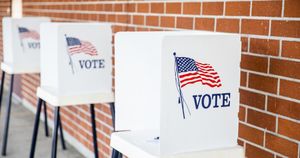Russia and Ukraine are deepening their conflict with unprecedented drone attacks, marking some of the most intense hostilities seen since the war began. Reports are surfacing about significant developments on both sides, as each nation escalates its aerial warfare capabilities. Initial attacks have not only underscored the growing sophistication of their military technologies but have also brought about increased tension within regions close to the war.
On November 10, the situation sparked alarm after Ukrainian forces reportedly launched dozens of drones targeting Moscow, forcing officials to temporarily close three major airports. These strikes signal Ukraine's commitment to exploiting every opportunity to strike back against Russian advances, especially from the air. The Russian Defense Ministry claimed these drone attacks were being met with significant defensive measures, but whether these efforts will hold up under continuous assault remains to be seen.
Meanwhile, the Russian military has concentrated its forces near Kursk, with Ukrainian President Volodymyr Zelensky confirming the presence of nearly 50,000 Russian troops. This is not simply about numbers; it's also about strategy. After Kyiv initiated its own unexpected offensive by crossing the border earlier this summer, Russia appears intent on reclaiming the initiative. Analysts suggest this back-and-forth is emblematic of both nations vying for dominance. Zelensky described the situation as one where Ukrainian troops are actively engaging with their adversaries, trying to thwart Russian intentions.
The Kremlin's response to the drone warfare is multifaceted. Not only does it include boasts of military victory, but there are also attempts to downplay casualties and any signs of weakness at the front. Russian officials have lately claimed they captured key locations, like the Ukrainian town of Voltchenka, amid reports from independent analysts cautioning about the heavy toll the war has already taken on Russian soldiers. British military assessments indicate Russia experienced around 1,500 casualties per day back in October, highlighting just how devastating this conflict has been for both sides.
Interestingly, instead of addressing the significant military losses openly, the Kremlin’s narrative tends to focus on Ukraine’s supposed aggression. For example, Russian officials persistently frame the drone attacks as provocations, and during press briefings, they often dismiss Ukrainian military successes. Dmitry Peskov, spokesperson for President Vladimir Putin, labeled reports of enhanced Ukrainian drone capabilities as exaggerated and emphasized the need for national fortitude.
Yet, amid these confrontations, there’s also talk about potential future dialogues, particularly concerning international dynamics influencing the conflict. Behind the scenes, political maneuvering suggests external players, including the new U.S. administration led by President-elect Donald Trump, may take on roles shaping the course of the war. Early indications from Trump signaled intentions to approach relations with Russia differently, which encouraged speculation about what impact his policies could have on the conflict.
During his initial conversation with Putin, Trump is reported to have urged restraint concerning Ukraine, which reflects his broader commitment to maintaining military pressure. Nonetheless, some experts remain cautious about the reality of such discussions leading to tangible outcomes. The historical backdrop of Trump’s previous interactions with Russia, such as his reluctance to impose sanctions after taking office previously, raises questions about consistency and potential accountability.
Further complicate the issue, Russia has managed to secure assistance from North Korea, reinforcing their capabilities amid the heightened assault on Ukraine. The peculiar alliance brings another layer of complexity to the situation, particularly with both factions employing spies and others to gain tactical advantages. Ukrainian officials have noted occurrences where drones and other military hardware are being utilized to target areas as far as Moscow, underlining the conflict's extent.
Analysts also warn about the potential ramifications should Russia continue its assault without concern for outcomes, as the international community is closely monitoring the developments. A continued escalation could provoke wider geopolitical ramifications, drawing even more nations to either side of the conflict. This might eventually require U.S. intervention or solidarity with NATO efforts to stabilize European nations feeling the repercussions of the war.
Despite the increasing drone activity and the intense rhetoric from both sides, the war remains far from resolution. While advancements are made, public sentiment within Ukraine seems to bolster resilience against Russian aggression. Meanwhile, internal discord might spur Russian frustrations as the war continues without clear victory.
Overall, both Russia's claims and Ukraine's defensive maneuvers serve as reminders of how precarious the situation is. Continually shifting alliances, military strategies, and internal politics remain at play, making the horizon of peace appear increasingly distant.



